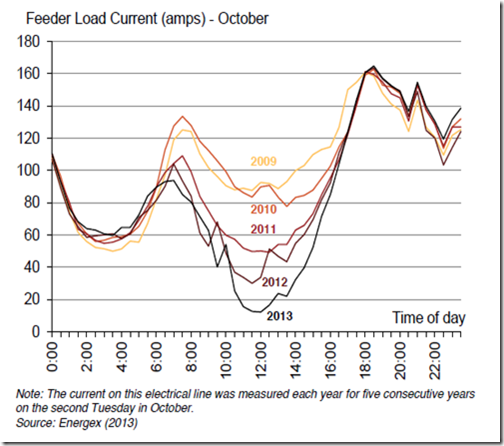Australia is unusual in the fact that more than 50% of electricity bills are related to network costs.
The big issue is that networks must be built to handle the highest load of the year. The development of solar panels means that the generation in the middle of the day is reducing the average load, while the peak demand is largely unchanged.
We need to develop a process to encourage load peaks to reduce.
In the figure below for a feeder in Caloundra the midday load is reducing as solar power levels increase but the evening peak is almost unchanged. Automated use of batteries and demand shifting is the main hope for addressing the peak demand issue.
The problem at the moment is that the electricity tariffs provide no incentive to residential premises to reduce the peak.
However, create a market and the solutions will be found.
There have been proposals for a high charge for the 4 hours around the evening peak and a medium charge for another 4 hours adjacent to that. The problem with this crude form of incentive is that it is not reflective of any real network constraint. If the real peak lasts 1 hour then increased charging for a longer time makes some solutions less viable. Similarly, if the time of peak shifts to 10pm the tariff is creating a new problem rather than actually reducing the peak.
The appropriate charge is to reflect the long run real cost of supplying the loads.
The wrong way
If the price charged for electricity jumps by a factor of 10 at 6:15pm on some nights, all it does is to annoy customers with no real possibility of maintaining changes in the use of lights and TV for the long term.
The right way
What a real cost-reflective tariff should incentivise is automatic control of items such as pool pumps, hot water systems, clothes dryers and batteries to limit the draw at peak times. The response can be within parameters set by the customer possibly responding to signals sent about network congestion.
Location matters
For some areas there is not a congestion problem and the charges should reflect the ownership cost of the poles and wires. In other areas the peak load growth can be driving substantial network costs and it is these areas where a cost reflective pricing would drive investment in batteries and peak load reduction through automated responses.
Why change?
The current scheme is potentially on a path to a “Death Spiral” where increasing network costs encourage some customers to buy batteries and go “off-grid”. This raises the network costs for remaining customers, which incentivises a new wave of customers to go “off-grid”.
Introducing true cost reflective pricing will provide a reward for customers with batteries to stay on-grid.
Winners and Losers
The costs for rural customers could rise substantially but other parts of the social security/tax system are a better mechanism to encourage right decisions than highly subsidized electricity bills.
How it might work
One option for the future is given in the figure below, which shows aggregators responding to the real costs and making a market arrangement with customers to make load variations in line with network needs.
About our Guest Author
| Professor Gerard Ledwich has been at QUT since 1999 and is currently Discipline leader for Power Engineering as well as Theme Leader in the Institute for Future Environments.
As far as the WattClarity editors can tell, Professor Ledwich is not on LinkedIn – but you can see more information about him on his staff profile page on the QUT website here. Also provided online is this listing of publications Professor Ledwich has contributed to. |





If only the government didn’t mandate peak/offpeak hours. Great article how do we spur more debate on this issue.
thanks for the commment, we are working with economists to put a good case to government.
Great article!
You could also charge for capacity and energy separately like for large customers. Many homes already have interval meters or smart meters. Such tariffs have encouraged offpeak heating and cooling systems to be built in the US.
most interval meter systems are poorly matched to real network congestion and thus do not make the best case for alternatives
Interval meters don’t have to mean TOU. You can measure customer load over an interval and charge based on average kW. It’s not as good as peak kVA but it’s a start.
A part of the ‘big issue’ is that networks in some States have been built much larger than the largest load. Better pricing is important, but the AER putting the clampers on high costs and over-investment will deliver the first and biggest wins for all consumers.
A certain margin is sometimes necessary, in the CBD in Brisbane a few years ago it was fed by a few old cables whose status was not fully known. We were running a risk like Auckland which was not fully restored for up to several weeks. Thus instant capacity compared to peak load (particularly for CBD) is not a good measure of a gold plated network, it is likely to be driven by reliability standards.
That is much less true for suburban areas and congestion pricing is much more necessary.
When ever I talk to networks companies about this issue they almost inevitably tell me the problem is “lack of granular data”, IPART said the same thing a few years ago. They either don’t know or can’t manage the data fast enough to offer genuine or dynamic pricing signals; so they smear things in a crude way.
In fairness, they are under huge pressure to reduce costs and so new data systems and analysis doesn’t seem to be on their agenda and of course, the current regulations don’t really incentivise or encourage innovation.
Seems to me (happy to be corrected) that rethinking the regulations and incentivising granular data collection is fundamental to changing the status quo?
It seems to me we do need to move to a new regeim , it may be that it will take new players to find the business case.
Prof. Ledwich, you forgot to mention the role of Energy Efficiency.
Much better Building Energy Efficiency Standards than the prevalent 6-star standard – which is not checked after the build by the way – would help a lot to bring down the peaks. 8-star homes should be mandated and insulating homes should be incentivised again.
There are two main factors contributing to the peak:,
The first is aircon use to bring down the temperature in these inefficient ‘glorified tents’ as they were also called. An efficient home like a 9-star home needs minimal cooling, meaning a much lower peak.
The second culprit is cooking. Unfortunately with cooking nothing much can be done to reduce the peak, except for mandating efficient appliances. An efficient fridge is using 100 Watts whereas an old inefficient one can use up to 400 Watts. The same goes for ovens etc.
I agree that control of hot water and pool pumps during peak times (or mandating efficient pool pumps) is also necessary. Hot Water could mandatorily be heated during the day which the ‘duck shaped demand curve’ above shows is reasonable. Unfortunately the Newman Government also got rid of the heat pump or solar hot water requirement for new housing.
I disagree that lighting and TV use is contributing much to the peak
They would possibly contribute a maximum 600 Watts to the peak, depending on the house of course (except for plasma TV’s – not very common nowadays). LED downlights bring that value down quite a bit as well.
Cooking and aircon use however would draw 5000 W and on average around 2000 Watts.
Another factor is diminishing the willingness of people to save at peak times.
Because daily network charges are so high now – at least in Qld – saving electricity doesn’t really save the customers a lot anymore. Going back to low daily charges would be a lot like TOU charges because every kWh used would in this case signal that it costs them more to use more without having TOU rates. This isn’t the case anymore with high daily connection charges. My bill is over 50% made up of these charges.